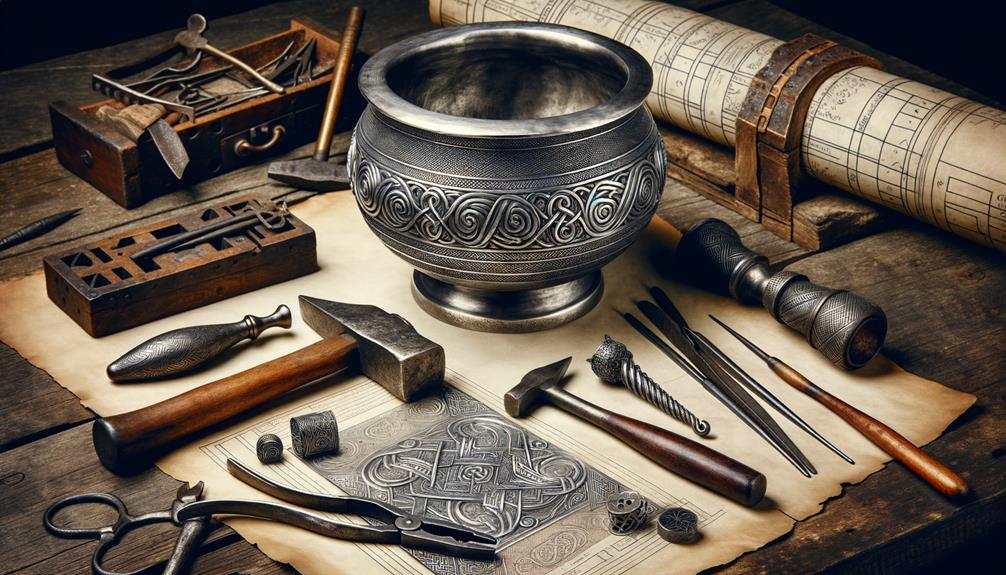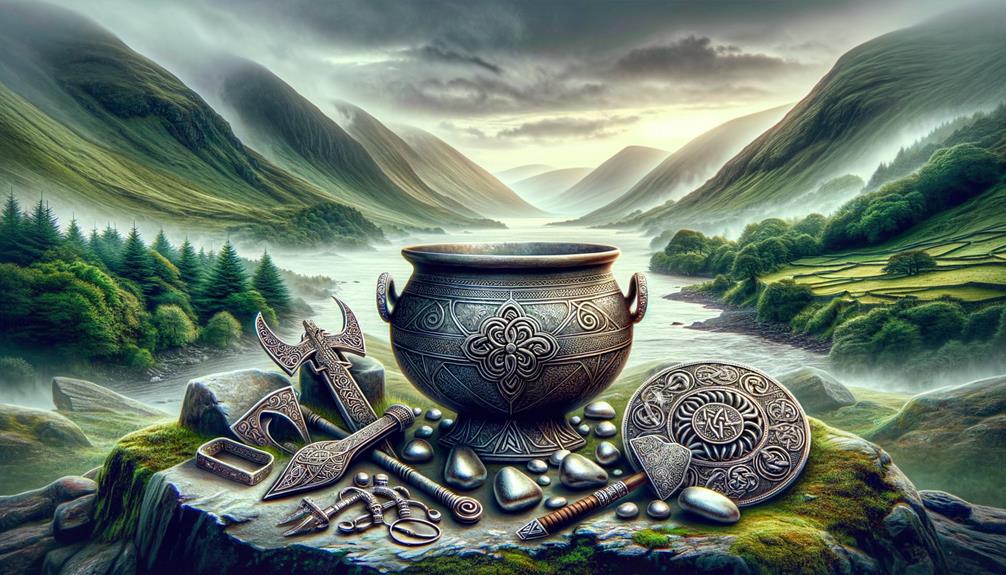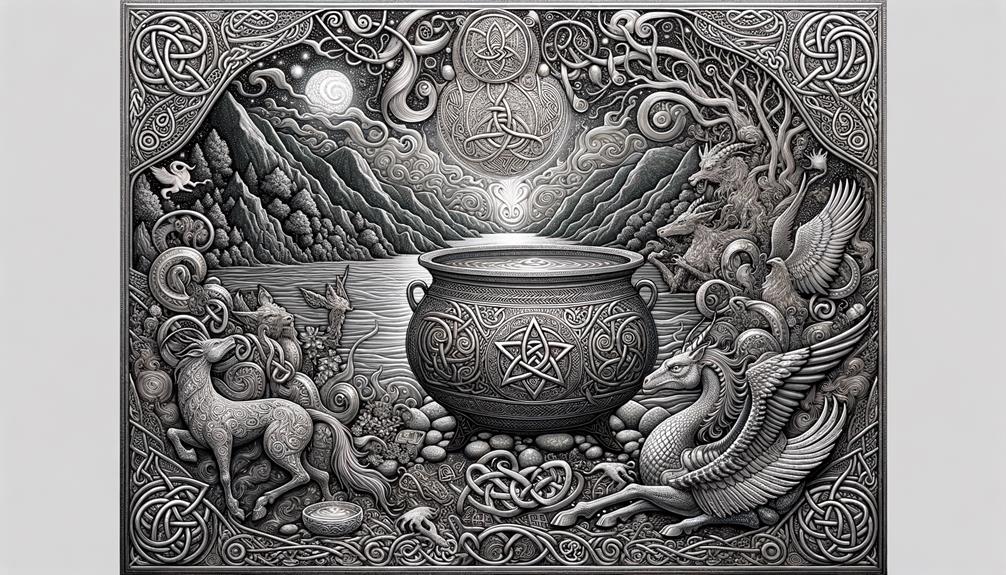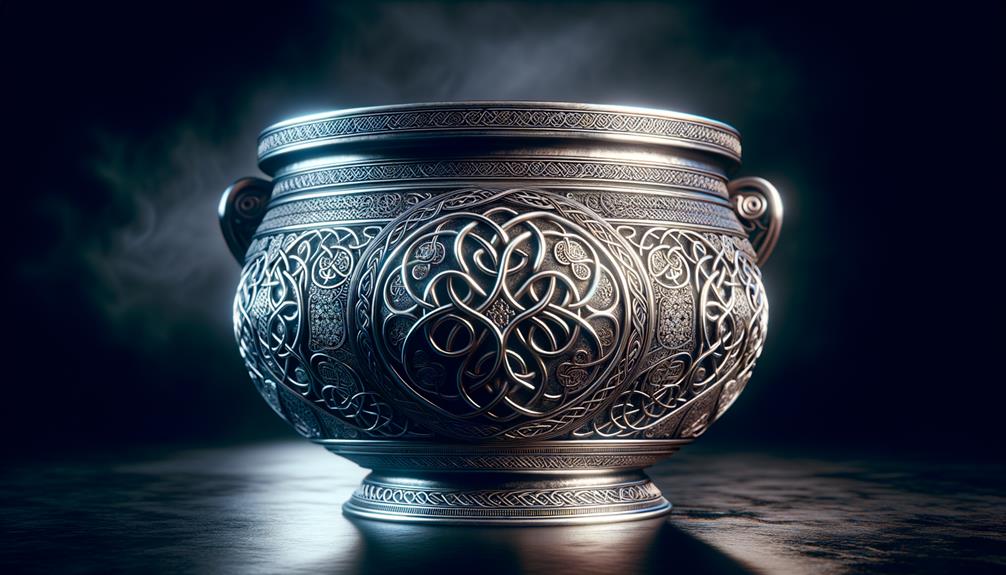The Gundestrup Cauldron, unearthed in Denmark in 1891, is an extraordinary example of ancient Celtic silver craftsmanship. This relic, pieced together from a collection of painstakingly arranged fragments, beautifully fuses Celtic and Thracian silverwork traditions, bestowing it with a distinctive cultural significance. The origins of the materials trace back to northern France and western Germany, hinting at the extensive influences that contributed to its formation.
The cauldron is adorned with complex designs, each providing a glimpse into Celtic mythology and spiritual beliefs. Interestingly, the use of repurposed materials reflects a surprising element of practicality in Iron Age craftsmanship. The cauldron is a fascinating subject, offering a wealth of information ranging from the production techniques to the symbolic representations. It's like peeling back layers of historical intrigue.
Discovery of the Gundestrup Cauldron
In 1891, a fascinating artifact was dug up from a peat bog near the village of Gundestrup in Aars, Himmerland, Denmark. Known as the Gundestrup cauldron, it was found in pieces, with its plates neatly stacked inside the base. This unusual find hints at a possible effort to hide it, likely due to its high value.
Studies on ancient plant life indicate that the cauldron was left there when the terrain was dry, only to be gradually enveloped by peat over time. The task of putting it back together fell to Sophus Müller, who had to meticulously figure out the proper placement of each plate. His interpretation, however, has been met with differing opinions, sparking lively discussions among scholars about the cauldron's original configuration.
The Gundestrup cauldron's discovery has provided more than just a stunning artifact; it has also been a catalyst for academic investigation and discourse. It's an ongoing conversation among researchers, with different perspectives and interpretations adding depth to the understanding of this fascinating relic.
Metallurgical Analysis and Reconstruction

Let's have a chat about the fascinating metallurgical examination of the Gundestrup Cauldron. This isn't just about where the materials came from; it's a testament to the intricate and advanced metalworking skills of Celtic artists. A deeper look into the scientific research gives us a clear vision of the careful reconstruction process of this timeless piece of Celtic creativity.
Cauldrons Silverwork Techniques
Studying the metallurgy and reconstruction of the Gundestrup cauldron uncovers a captivating mix of Celtic and Thracian practices in silverwork. These techniques are accentuated by the materials mainly gathered from regions in northern France and western Germany. The cauldron, predominantly crafted from silver, also incorporates gold for gilding, tin for solder, and glass for the eyes of depicted figures.
Interestingly, the silver tells a tale of recycling – it's been melted and reused on numerous occasions. This showcases the resourcefulness of early craftspeople. The gold used for gilding the cauldron shows variations in purity and how it adheres to the silver, reflecting the detailed handiwork involved in applying these precious metals.
The marriage of Celtic and Thracian silversmith methods in the Gundestrup cauldron crafts a striking testament to early cross-cultural metallurgical practices.
Reconstructing Celtic Artistry
Diving into the journey of reconstructing the Gundestrup cauldron, we can appreciate the blend of Celtic and Thracian techniques used in its creation. This undertaking wasn't a walk in the park, as it needed painstaking metallurgical analysis and a profound respect for Celtic artistry. It was a bit like solving a complex puzzle, arranging plates based on solder traces and puncture marks.
What's striking is the cauldron's silver, which was sourced from various Celtic regions, showing off the masterful Celtic silver craftsmanship. The cauldron's figures are adorned with gold and tin, even glass eyes, revealing a level of intricate artistry that's truly Celtic in nature.
While there was some back and forth about the order of the plates, the reconstruction process brought to light the blend of Thracian techniques and Celtic art. It gave us a fresh look into the skills of ancient craftsmen.
Scientific Examination Insights
The scientific exploration of the Gundestrup cauldron, an ancient artifact, offers several intriguing facts about the metallurgical techniques of yesteryears. Here are some key takeaways from the study:
- The cauldron was predominantly made of silver, which was extracted from various ore deposits scattered across northern France and western Germany. This was revealed by lead isotope studies, a clear indication of a complex acquisition process.
- The makers of the cauldron utilized recycled silver, which was repeatedly melted and reused. This shows an early understanding of sustainability.
- Gold was used in the cauldron as well, but with two separate gilding methods, each varying in terms of purity and how it clung to the silver.
- The restoration of the artifact was a detailed process, with solder alignments and puncture marks used to uphold the original Celtic art's integrity.
This study showcases the intricate and advanced metallurgical practices in ancient times. It's important to remember that these findings aren't just fascinating glimpses into the past, but also testament to the ingenuity of our ancestors.
Origins and Raw Material Sources

If you're interested in the fine artistry of the Gundestrup cauldron, it's pretty cool to note that its main component, silver, comes from the Celtic regions of northern France and western Germany. They would take silver from various ore deposits, and interestingly, a lot of it was recycled. The Celts were really efficient and eco-friendly with their metalworking.
Now, the cauldron isn't just silver. They also used gold for delicate gilding, which adhered in an intricate pattern to the silver. The purity of the gold varies, which just adds to the charm. They even used glass to make the eyes of the figures, really making the artistry pop.
What's also interesting is that the techniques used to work the silver are very similar to those used in the Thracian tradition. It's like a melting pot of influences. The combination of different materials and techniques really shows how the Celts balanced what was available with their creativity in crafting the Gundestrup cauldron. It's a testament to their ingenuity and skill.
Detailed Description of Depictions

Take a look at the Gundestrup cauldron, and you'll see a beautiful array of characters and scenes, all laid out in great detail. Let's start from the base plate, where you'll find a bull, a female figure with a sword, and two dogs. This sets the tone for the story that unfolds.
- On the exterior plates, we see men with beards and women, all caught up in fascinating scenarios. You'd find one clutching a boar and sea-horses, sparking your interest.
- Moving to the interior, plate A has an antlered man holding a torc and a horned serpent, setting a mysterious tone.
- Plate B is quite a sight with a female bust surrounded by wheels, elephants, and griffins, leaving one in awe.
- Plate C features a man with a beard holding a broken wheel, with griffins around him, creating an intriguing scene.
These depictions together create a vibrant and engaging visual story, making it a fascinating and complex piece of art.
Cultural Interpretations and Parallels

The Gundestrup Cauldron offers a fascinating look at a medley of cultures and traditions. This beautiful piece of art is a blend of influence from Gaul, Thrace, and the Near East. Some of its imagery even seems to echo ancient India and the religious customs of Proto-Indo-Europeans. This fusion of different cultures, each symbol layered with its own meaning, creates connections across various historical contexts. It gives us a deeper glimpse into Celtic mythology and the art of Europe.
Interpretations of Symbolic Imagery
When you take a good look at the Gundestrup cauldron's complex symbols, you can't miss the mix of Gaulish, Thracian, and Near Eastern artistic elements. It's like a vibrant patchwork of cultural influences. The symbols on the cauldron tell a fascinating tale of common mythological themes across Celtic cultures and even broader Proto-Indo-European religions.
- The Gundestrup cauldron's symbols are like echoes of Gaulish, Thracian, and Near Eastern influences. They show how these ancient cultures were linked.
- The symbols on the cauldron give us an exciting opportunity to learn about the complex beliefs of ancient Celtic and Proto-Indo-European religions.
- The themes we see in the cauldron's mythology also pop up in the ancient Near East. This suggests there was a lot of cultural exchange happening back then.
- There are some interesting similarities between the symbols on the cauldron and Hindu deities. This could mean these shared symbols and stories had a wider reach than we first thought.
Parallels in Celtic Artifacts
If you take a good look at the intricate designs on the Gundestrup cauldron, it's clear to see some fascinating similarities with other Celtic artifacts from the Iron Age. The detailed imagery, filled with depictions of Celtic gods and spiritual symbols, not only provides a glimpse into Celtic culture but also uncovers cultural influences from Gaulish, Thracian, and Near Eastern art traditions. This mixture of diverse cultural elements points to a wide-ranging cultural exchange during the Iron Age.
Let's discuss these similarities more in the following table:
| Artifact | Depiction | Cultural Influence |
|---|---|---|
| Gundestrup Cauldron | Celtic gods, animals, scenes from mythology | Gaulish, Thracian, Near Eastern |
| Celtic Coins | Celtic gods, animal figures | Gaulish |
| Celtic Jewelry | Geometric patterns, animals | Thracian, Near Eastern |
| Celtic Sculptures | Celtic gods, figures from mythology | Gaulish, Thracian |
| Celtic Manuscripts | Celtic gods, elaborate knotwork | Near Eastern, Gaulish |
This table helps us understand the shared imagery and cultural influences found in Celtic artifacts. It's fascinating to see how interconnected our world was, even during the Iron Age!
Gundestrup Cauldron in Celtic Mythology

The Gundestrup cauldron, a fascinating artifact, is a melting pot of Gaulish, Thracian, and Near Eastern art forms. This jumble of cultural influences is a testament to the diverse origins of Celtic mythology, with its decorative plates teeming with mythical beasts and the mysterious god, Cernunnos.
- This cauldron carries symbolic echoes from the Proto-Indo-European religion, stirring a deep spiritual resonance in those who study it.
- The Gaulish art elements are woven into the design in a way that amplifies the artifact's beauty.
- The cultural influences reflected in the detailed designs stir a profound appreciation for the crafters' fusion of different traditions.
- The vivid representation of Celtic mythology stirs wonder and piques interest in these ancient beliefs.
These elements come together beautifully in the Gundestrup cauldron, offering us a fascinating glimpse into the world of Celtic mythology.
Frequently Asked Questions
What Does the Gundestrup Cauldron Symbolize?
The Gundestrup Cauldron is thought to be a nod to Celtic mythology. Scholars suggest that the detailed artwork might be portraying a mix of gods, animals, and mythical beings. Yet, there's no one-size-fits-all explanation for this intriguing piece of history. Its symbolism is up for debate, only adding to its allure and intrigue.
Where Is the Gundestrup Cauldron Now?
Did you know that the stunning Gundestrup Cauldron is housed at the National Museum of Denmark in Copenhagen? It's truly a remarkable piece. It features detailed patterns that seamlessly blend various art styles from Gaulish, Thracian, and Near Eastern cultures. It's worth checking out if you ever find yourself in Copenhagen!
How Old Is Gundestrup Cauldron?
As a fan, I'm quite fascinated by the Gundestrup Cauldron. Did you know it's believed to be from the late Iron Age, dating back to the 2nd century BCE? This isn't just a guess – it's based on some solid evidence. Things like archaeological finds, analysis of the metal used, and comparisons with other artifacts from that era all point to this time period. It's amazing, isn't it?
What Is a Celtic Cauldron?
You know, it's fascinating when you think about the Celtic cauldron. It's not just a big, fancy pot. It's a solid representation of the wealth and generosity that were key values in Celtic culture. These cauldrons, often used during big celebratory meals, were more than just functional. They were practically pieces of art, showcasing the incredible skill of the artisans with their complex and detailed patterns. It's a testament to their culture and a glimpse into their world. And that's pretty cool, don't you think?


